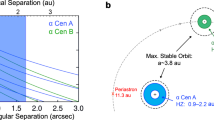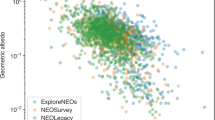Abstract
Owen1 has reviewed the potential for detecting life on Earth-like planets of nearby stars, from atmospheric spectra. The presence of oxygen, as revealed, for example, by the 7,600-Å absorption band, would be of particular significance. But even the direct detection of a Jupiter-like planet around the nearest star is a formidable task, perhaps just possible with the Hubble Space Telescope2,3 or with a Michelson interferometer operating at 40-µ wavelength4. Earth-like planets, being fainter and closer in, are still more difficult. Here we show that a space telescope of 16 m diameter, apodized in a new way, could image and measure oxygen in the thermal infrared spectra of earthlike planets up to 4 pc away. Several interesting candidate stars lie within this distance.
This is a preview of subscription content, access via your institution
Access options
Subscribe to this journal
Receive 51 print issues and online access
$199.00 per year
only $3.90 per issue
Buy this article
- Purchase on Springer Link
- Instant access to full article PDF
Prices may be subject to local taxes which are calculated during checkout
Similar content being viewed by others
References
Owen, T. Strategies for the Search for Life in the Universe (ed. Papagiannis, M. D.) 177–185 (Reidel, Dordrecht, 1980).
Davies, D. W. Icarus 42, 145–148 (1980).
Breckinridge, J. B., Kuper, T. G. & Shack, R. V. Opt. Enginng 23, 816–820 (1984).
Bracewell, R. N. & MacPhie, R. H. Icarus 38, 136–147 (1979).
Burke, B. F. Detection of Life in Other Planetary Systems, Nature (in press).
Rose, H. et al. The Handbook of Albedo and Thermal Earthshine (Environmental Research Institute of Michigan, Ann Arbor, Rep. No. 190201-I-T, 1973).
Ruze, J. Proc. IEEE 54, 633–640 (1966).
Elson, J. M., Bennett, H. E. & Bennett, J. M. Applied Optics and Optical Engineering Vol. 7 (eds Shannon, R. R. & Wyant, J. C.) pp. 191–244 (Academic Press, New York, 1979).
Bahcall, J. N. & Spitzer, L. Scient. Am. 247, 40–51 (1982).
Mason, P. V. & Mount, K. JPL Memo (10 Feburary 1984).
Angel, J. R. P. Proc. South-west Conference on Optics (eds McDowell, R. S. & Gerada, J. B.) Proceedings of the SPIE, 542, 32 (1986).
Alien, C.W. Astrophysical Quantities (Clowes, London, 1973).
Author information
Authors and Affiliations
Rights and permissions
About this article
Cite this article
Angel, J., Cheng, A. & Woolf, N. A space telescope for infrared spectroscopy of Earth-like planets. Nature 322, 341–343 (1986). https://doi.org/10.1038/322341a0
Received:
Accepted:
Issue Date:
DOI: https://doi.org/10.1038/322341a0
This article is cited by
-
Space-based infrared interferometry to study exoplanetary atmospheres
Experimental Astronomy (2018)
-
The Way Forward
Space Science Reviews (2016)
-
Spectroscopy of planetary atmospheres in our Galaxy
The Astronomy and Astrophysics Review (2013)
Comments
By submitting a comment you agree to abide by our Terms and Community Guidelines. If you find something abusive or that does not comply with our terms or guidelines please flag it as inappropriate.



